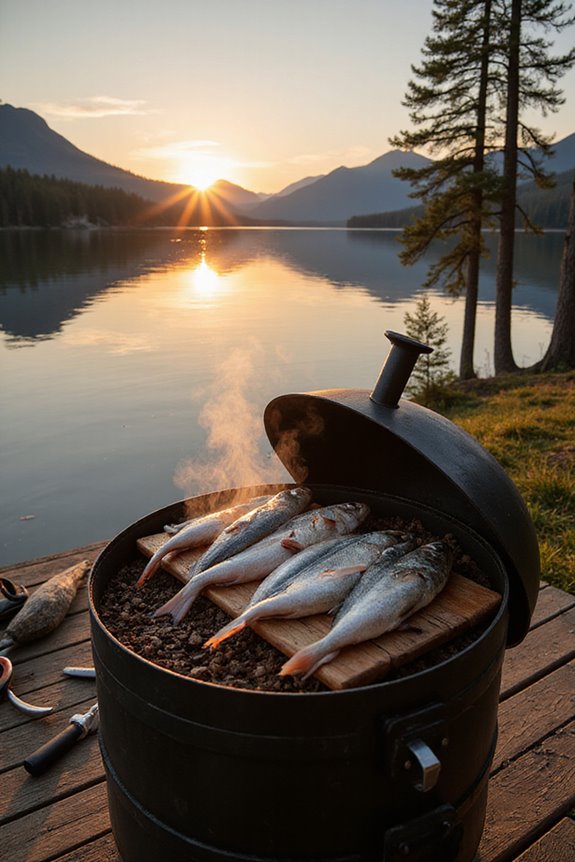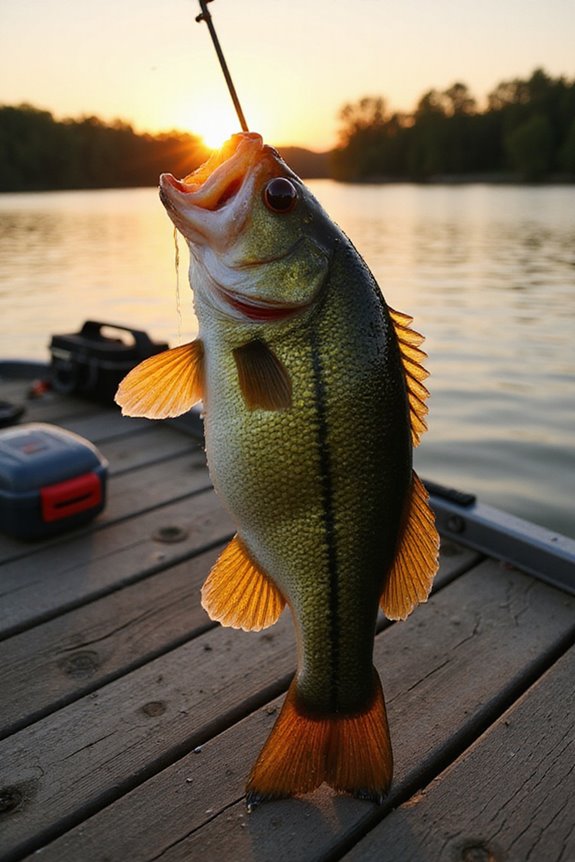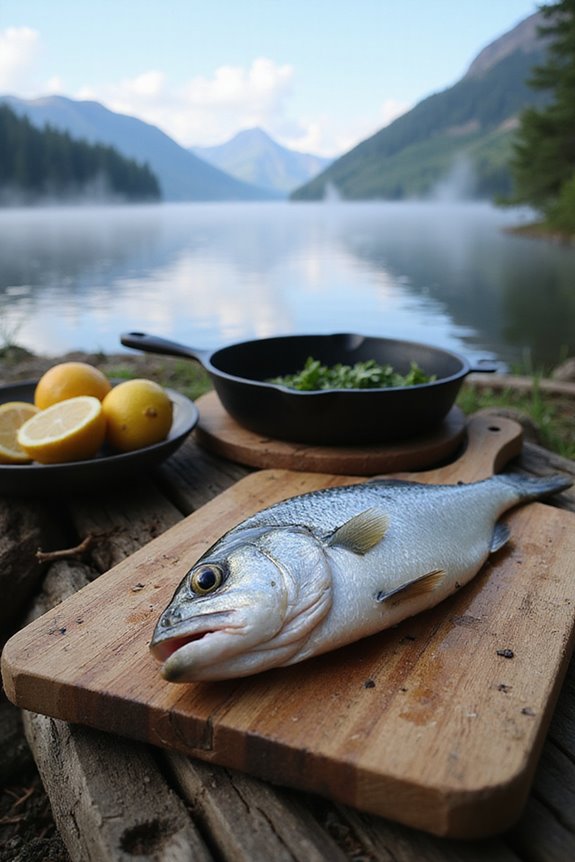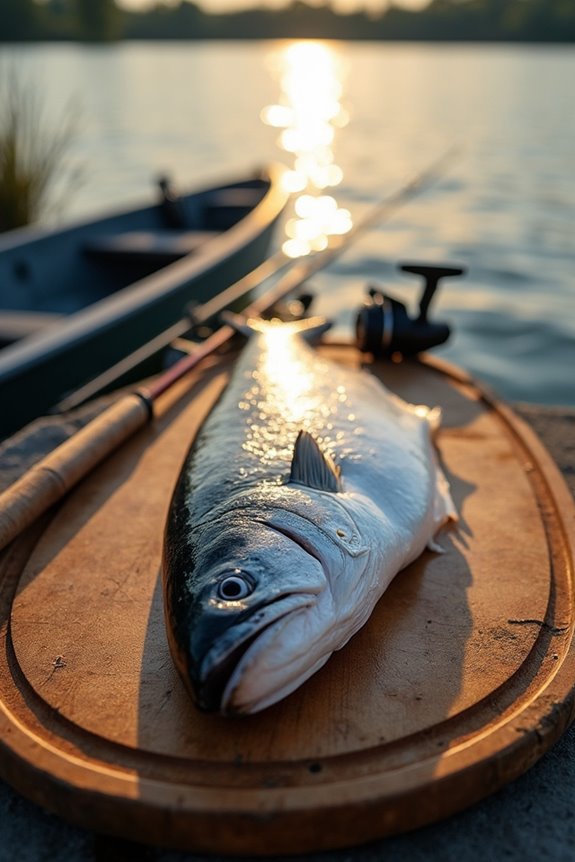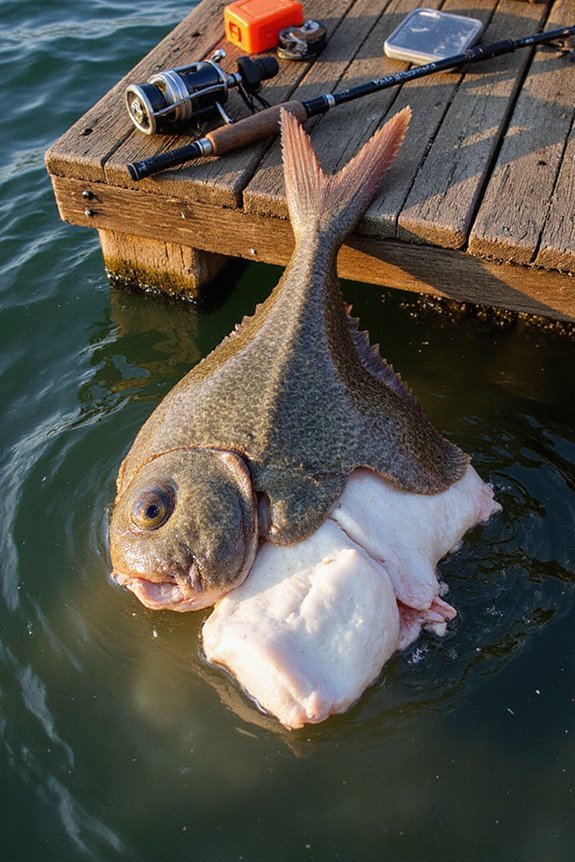To smoke fish, start by selecting oily fish, like salmon, for their high-fat content. Next, descale and brine the fish in a mix of non-iodized salt and sugar for flavor. Air-dry the fish to create a tacky surface. Preheat your smoker to a stable 200°F to 225°F, using food-safe wood chips like apple or cherry. Monitor internal temperature, aiming for 145°F. Proper technique and equipment guarantee a flavorful outcome, leading to delicious results in future endeavors.
Key Takeaways
- Select suitable fish like salmon or trout, ensuring freshness from reputable suppliers for optimal flavor and texture.
- Descale, brine, and lightly rinse the fish, then air-dry to form a tacky pellicle for better smoke adhesion.
- Preheat your smoker to maintain temperatures between 200°F and 225°F, using a water pan to control humidity.
- Monitor internal fish temperature, aiming for at least 160°F, and look for visual cues like opacity and easy flaking.
- Experiment with different wood chips for unique flavors, and ensure proper smoker maintenance for consistent results.
Selecting the Right Fish for Smoking
When selecting the right fish for smoking, it’s essential to take into account both the type of fish and its characteristics. For my fish selection, I often gravitate toward oily fish like salmon or mackerel due to their high fat content, which helps retain moisture and absorb smoke flavors effectively. Firm-fleshed fish, such as trout, are also excellent choices because they hold together well during smoking. I consider the size of the fish too; smaller fish smoke faster and more evenly. Skin-on fillets improve handling and presentation, making them easier to manage. Freshness is important, so I always source high-quality fish from reputable suppliers, ensuring the best flavor and texture after smoking. Similar to choosing the right seasonal awareness for bass fishing, understanding when certain fish species are at their peak quality can significantly improve your smoking results.
Preparing the Fish: Descaling and Brining
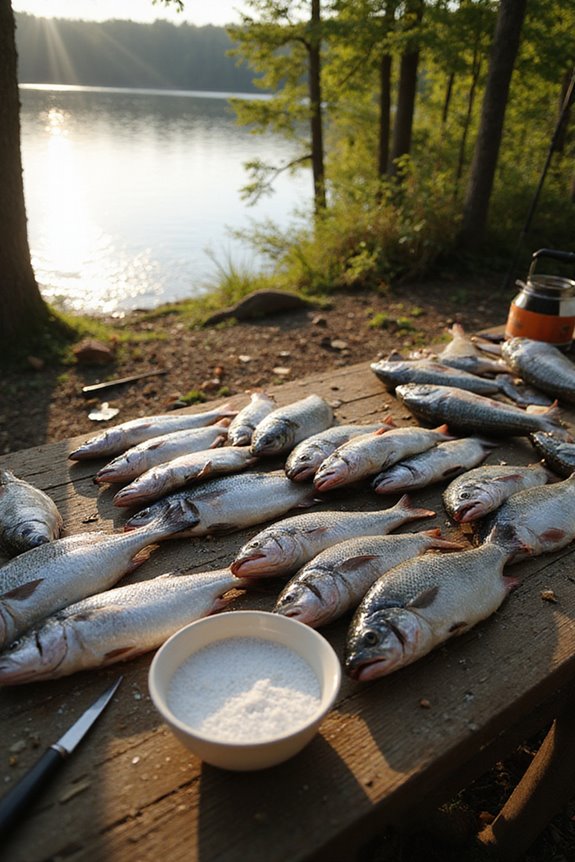
Preparing the fish for smoking involves two key steps: descaling and brining. I usually start with descaling techniques, which can vary based on the fish type. For filleted fish, I find using a fish scaler or the back of a knife works best, scraping gently to avoid tearing the skin. I recommend using a stainless steel scaler with serrated edges that captures loose scales to minimize mess during the process. Next, I move on to brining methods, which enhance flavor and moisture. I mix non-iodized salt, sugar, and optional spices in cold water, ensuring a concentration of 5% to 10%. I submerge the fish fully in a non-reactive container, turning it occasionally. Brining times vary; smaller fish need about 2-4 hours, while larger cuts can take up to 12 hours. After brining, I rinse the fish lightly and pat it dry.
Air-Drying the Fish for Optimal Smoking
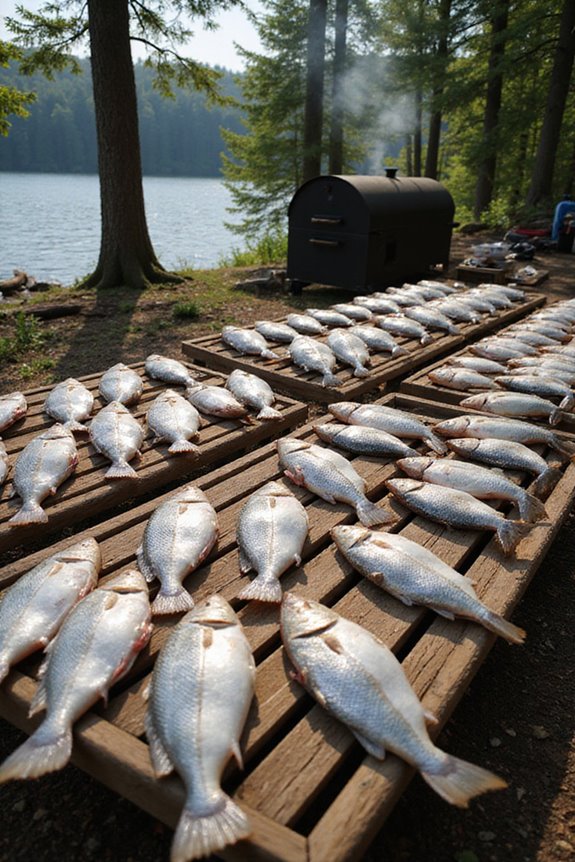
Air-drying the fish before smoking plays an essential role in achieving perfect flavor and texture. I recommend using air drying techniques that guarantee ideal conditions, like keeping the fish in a dry, cool environment. After rinsing off any brine, I pat the fish dry with paper towels and lay it skin-side down on racks for proper airflow. Depending on the humidity and temperature, I find that two hours in a refrigerator works well for forming a tacky pellicle. If conditions are less than perfect, I sometimes use my smoker at a low temperature, around 80 to 90°F, keeping the doors open for gentle drying. Monitoring barometric pressure while preparing fish can help you plan your smoking session during stable weather conditions for more consistent results. This process helps enhance smoke adherence and improves the overall quality of the smoked fish.
Setting Up Your Smoker: Temperature and Humidity
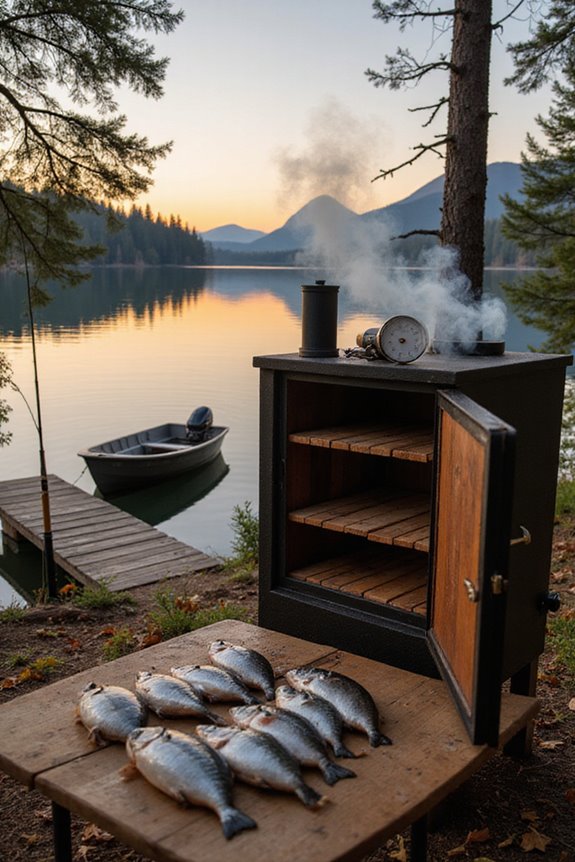
Setting up your smoker correctly is essential for achieving delicious smoked fish, as the right temperature and humidity levels can greatly impact the final product. First, I recommend calibrating your smoker to maintain temperatures between 200°F and 225°F. This range guarantees fish cooks thoroughly while preventing dryness. Use a reliable thermometer to monitor both air and internal fish temperatures, aiming for at least 160°F inside the fillet.
For humidity control, I suggest placing a water pan in the smoker. This helps maintain moisture, preventing the fish surface from drying out. Additionally, adjust the smoker’s vents for proper airflow, which influences both temperature and smoke quality. By managing these elements, you’ll enhance flavor and guarantee safe, delicious smoked fish.
Choosing the Right Wood Chips for Flavor
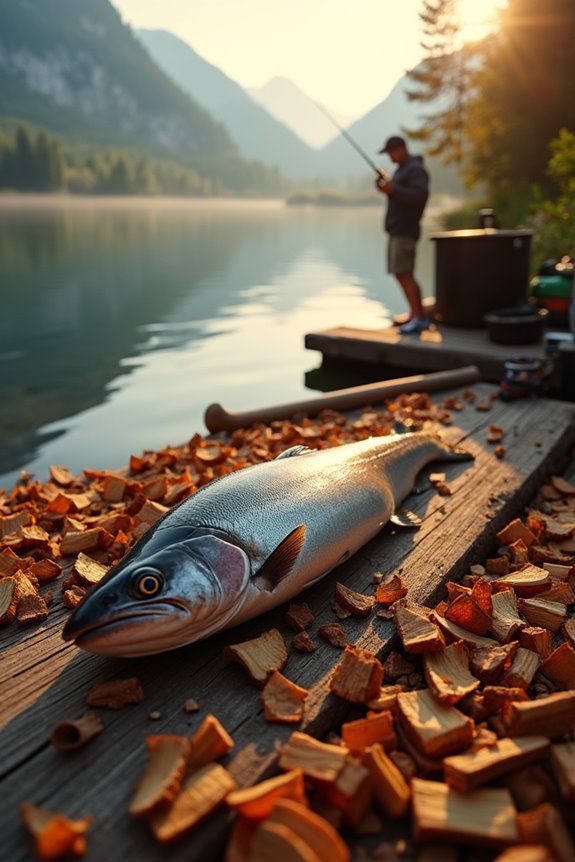
Choosing the right wood chips for smoking fish can greatly enhance the flavor profile of your catch. I recommend starting with alder wood chips, as they provide a mild, sweet smoke flavor that complements fish like salmon and trout. Applewood chips are another excellent option, adding a subtly sweet and fruity smoke, perfect for fatty fish. If you’re looking for something unique, cherry wood offers a sweet, slightly tart smoke that adds complexity and a reddish hue to your fish. For a more robust taste, hickory chips can create a strong, bacon-like flavor but should be used sparingly. Finally, oak wood chips provide a balanced smoky flavor that works well across various fish types. Always choose 100% natural wood chips for the best results.
The Smoking Process: Techniques and Timing
When you’re ready to smoke fish, understanding the smoking process is essential for achieving the best flavor and texture. I usually start by selecting the right smoking techniques based on the type of fish. For hot smoking, I preheat my smoker to a temperature between 145°F and 200°F. Timing considerations are vital; I let the fish form a pellicle for about 30 minutes to 3 hours before adding wood chips. I add these chips once the pellicle is set, ensuring a rich smoke flavor. The total smoking time typically ranges from 6 to 8 hours, depending on the fish type. Always monitor the internal temperature, aiming for at least 160°F for food safety.
Monitoring Doneness and Readiness
How can you guarantee your smoked fish reaches the perfect doneness? First, use a reliable thermometer to check temperature accuracy, aiming for 145°F for fully cooked fish or 120°F for smoked salmon. Insert a needle probe into the thickest part of the fillet to monitor continuously. Look for visual cues: the fish should appear opaque, have a shiny glaze, and flake easily. The surface should feel dry but not brittle. You can also measure weight loss; a 10% reduction indicates quality. Finally, keep an eye on cooking time, typically 3 to 6 hours, and adjust based on the thickness of your fillets. These steps guarantee your fish is delicious and safely smoked.
Post-Smoking Handling and Storage
Once your fish reaches the desired doneness, it’s important to handle and store it properly to maintain its quality and safety. Begin by cooling the fish rapidly to inhibit microbial growth. Within three hours, refrigerate it at or below 38°F (3.3°C). For effective post smoking storage, use vacuum-sealed bags to limit air exposure. Monitor the temperature continuously to prevent bacterial growth. If you plan to freeze the fish, aim for –20°C for at least 24 hours to guarantee safety. When handling, use clean, sanitized equipment to avoid cross-contamination. Always check for any signs of spoilage before consumption, discarding any fish that appears tainted or has an off smell. Following these handling procedures can help guarantee your smoked fish remains safe and delicious.
Safety Tips for Smoking Fish
To guarantee your fish is safe and delicious after smoking, it’s important to adhere to specific safety guidelines throughout the process. First, focus on temperature control; verify your fish reaches an internal temperature of 160°F for at least 30 minutes. I recommend using a standard meat thermometer to check the thickest part. Next, eviscerate fish longer than five inches to minimize bacterial contamination. Properly brine your fish, confirming a salt concentration of at least 3.5% in the muscle. Apply smoke consistently to deposit phenolic compounds that inhibit pathogens. Finally, refrigerate smoked fish promptly to prevent bacterial growth. By following these safety precautions, you’ll enjoy a tasty and safe smoking experience.
Essential Equipment and Supplies for Smoking Fish
When preparing to smoke fish, having the right equipment and supplies is crucial for a successful outcome. I recommend using a pellet smoker, as it offers precise temperature control and even smoke distribution. Look for adjustable vents and built-in thermometers to help with smoker maintenance and temperature regulation. For flavor enhancement, choose food-safe wood chips, like apple or cherry, which add unique tastes. Use fish racks to keep fillets in place and guarantee proper smoke circulation. Essential tools include digital thermometers, heat-resistant gloves, and cooking spray to prevent sticking. Finally, always have cleaning supplies on hand to maintain your smoker’s hygiene and prevent flavor contamination after each use. This careful preparation will yield delicious smoked fish.
Frequently Asked Questions
Can I Smoke Fish Without Brining It First?
Absolutely, I’ve smoked fish without brining! Using various smoking techniques, I found that direct seasoning enhances fish flavors beautifully. A good pellicle helps too. Just keep an eye on temperature for perfect results.
What Types of Fish Are Best for Beginners?
Choosing fish for beginners is like picking ripe fruit; salmon selection’s a favorite, while trout tips offer a delicate taste. Both are forgiving, making them perfect for learning the art of smoking fish successfully.
How Do I Prevent Fish From Sticking to the Smoker?
To prevent fish from sticking, I’ve found that proper fish preparation is key—keeping the skin on helps. Also, regular smoker maintenance, like cleaning and oiling racks, creates a nonstick surface for better results.
Can I Reuse Wood Chips for Smoking Fish?
When it comes to reusing wood chips, think of them like a once-brilliant song that’s lost its tune. I’ve found fresh wood chip types elevate my smoking techniques, ensuring that each bite sings with flavor!
How Long Can Smoked Fish Be Stored in the Refrigerator?
When it comes to smoked fish storage, I’ve found that unopened varieties last 7-10 days in the fridge. For refrigeration tips, always seal opened fish properly and consume within five days for the best taste.

